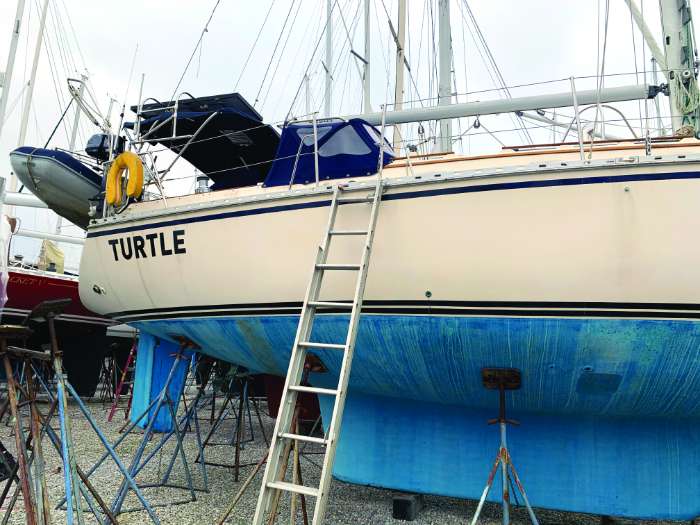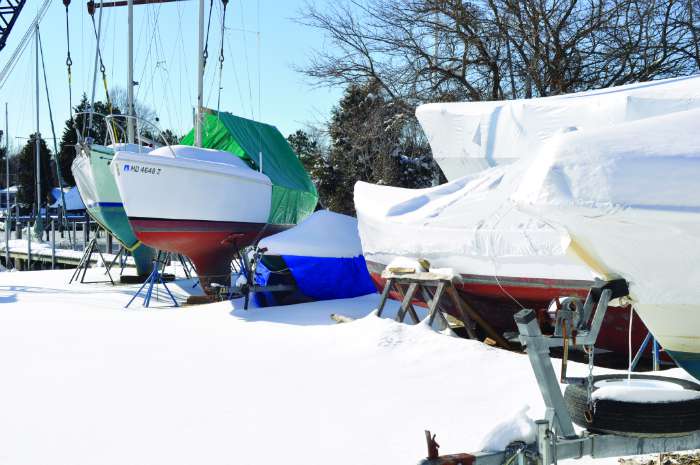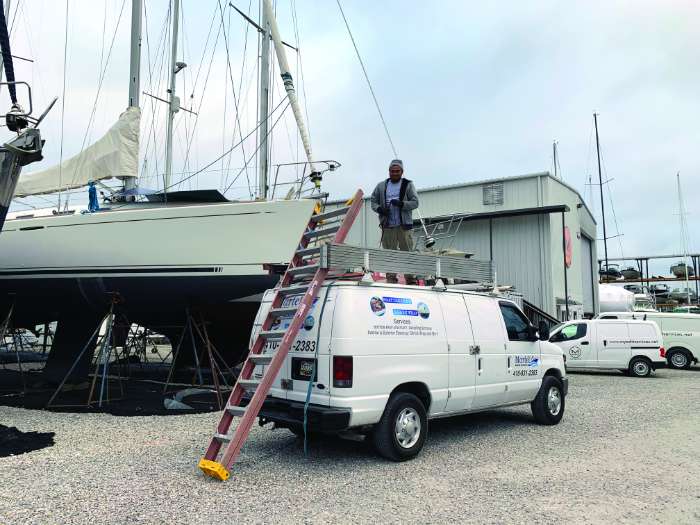Are You Ready To Winterize Your Sailboat? Here Are Six Tips:
The arrival of autumn entices us with a crispness in the air and a fall breeze that sailors relish after the heavy humidity of summer, but it also taunts us with the nibbles of winter’s chill and all that comes with the colder conditions. The Chesapeake’s mercurial seasons have a habit of serving us mixed messages that can make it difficult to gauge what the weather has in store, but by anticipating freezing temperatures and winterizing your boat, you can avoid consequences such as a cracked engine block and or burst plumbing.

Winterization is the process of preparing your boat’s systems for freezing temperatures. Depending on the boat, servicing your boat for winter can be much more complicated than one might think! Below are six aspects of winterization that boat owners might consider as we enter the end of fall and embrace the arrival of winter.
1. The long haul. Hauling your boat for winter is a personal choice. Some boaters choose to leave their boats in the water over the winter, while others will store them in a boatyard. Others will pursue options such as a trailer or garage storage situation depending on the size of your vessel.
The local yards usually begin to fill up in November, but it depends on the weather each year. If you are considering hauling your boat for this coming winter, you’ll want to get on the haul out list as soon as possible at your yard of choice, or you may be left with minimal options as they fill up.
Choosing a yard for the winter season will rely on availability, budget, and amenities that you need. Note that some yards allow you to work on your vessel yourself, while others require all servicing be provided by yard employees.
If your boat is already on the hard, but not yet winterized, you’ll need to winterize it sooner than if it was still in the water. Water serves as a natural insulator and keeps the boat warmer than when it is on land and surrounded by the cold air.

2. Knowledge is power. Some boats can be straightforward with only a few systems to winterize, but others can have much more complex systems to address. If you have complete comprehension and understanding of your vessel’s systems and absolute confidence in administering the proper techniques for winterizing them, you may choose to undertake winterizing your vessel on your own.
Although some boats can be simple and straightforward if they have none to minimal systems, boats with multiple systems will require in-depth servicing to be winter-ready. Any systems that utilize water will need to be winterized, such as fresh water systems, raw water systems, HVAC, watermakers, ice makers, refrigeration, and of course, your engines and generators you may have onboard.
Several marine service businesses and BoatUS offer downloadable winterization checklists available online to advise that you don’t forget anything, but even with these additional tools, winterizing your boat can be a daunting undertaking.
While there are individuals who will attempt and some may succeed to winterize their boats themselves, it can be quite time consuming, and the risk of error could lead to expensive consequences. Unless you are truly certain of all the steps that your boat needs to be winterized, hiring a professional marine technician is highly advisable. With their knowledgeable expertise and the right tools, they are readily equipped to successfully take your boat from summer to winter.
3. Fool-proof prep. If you’ve taken the route of hiring a professional, here are some tips to prepare your boat for their services before they arrive that can make the process go much quicker and smoother. Your technicians will surely appreciate the forethought.
Drain all freshwater plumbing systems. This will save your tech the time of waiting for your tanks to empty.
Empty the holding tank; you’ll want to store this dry over the winter.
Remove all cushions from the boat, as this will make it easier for technicians to access your systems. It’s also a great opportunity to remove the covers and wash them.
Clear out any refrigerated or frozen items from the icebox or refrigerator; don’t leave behind any consumables that could leak, rot, or attract creatures.

4. Sails away. Removing the sails during winter is another task to add to the list. Some sailors are confident with the removal of their sails, while others may find that they prefer to hire a rigger or marine technicians to remove their sails for them.
Ensure that sails are dry before storage and store them in a dry place, safe from the elements and pests. Sail lofts can offer sail storage at their facility that can be equipped with ideal humidity and temperature for sail storage, if perhaps you don’t trust the conditions and critters stowed away in your garage.
5. General maintenance. Routine servicing keeps systems in sound working condition after a season of usage. Oil and fuel systems do not need to be serviced at winterization, but it is a great opportunity for the necessary actions of replacing filters and doing an oil change.
If you are performing an oil change yourself, please dispose of the used oil appropriately. Napa Autoparts takes up to five gallons of used oil for disposal, free of charge.
Sometimes name brand filters may be so popular that they run out of stock. These days there are other manufacturers making the same filters just under a different part number and brand, which is a route that could save you time and money.
6. Bundle up. Although boats are designed to exist outdoors, tucking them away under a cover or shrinkwrap for winter shields your boat from rough and wet winter conditions and protects it from rodents, insects, bird droppings, and dust. Canvas covers can be custom-made or ordered online, while shrinkwrap is made of a durable plastic that can later be recycled.
Depending on your situation, you will likely want to remove any dodgers or biminis for preservation. Some folks choose to wash their canvas pieces with Woolite once a year to freshen them up.
If you plan on accomplishing projects on your vessel throughout the winter and are planning to have your boat shrink wrapped, adding a zipper door for easy access is a smart move. The Marine Trades Association recommends considering a longer lasting custom cover; find more about their initiative here.
About the Author: As well as being a sailing journalist, Chelsea Co has been a marine technician, sailboat owner, delivery crew, and SCUBA diver. Follow her marine adventures on Instagram @deepbluechelsea.




